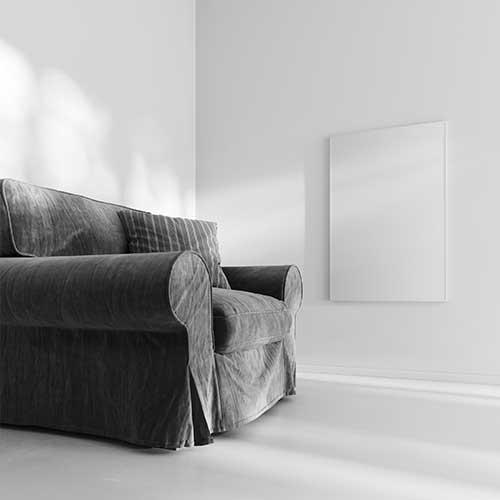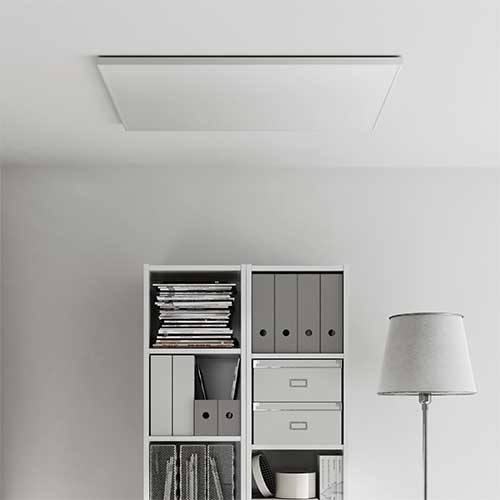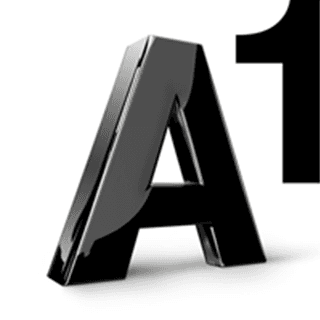Infrared heater experience: Costs, advantages and disadvantages & Co.
Infrarotheizungen zählen zu den elektrischen Heizsystemen. Sie nutzen die Infrarottechnik, um möglichst effizient und umweltschonend zu heizen. Während manche Verbraucher von ihrem praktischen Nutzen begeistert sind, halten Kritiker sie für eine teure Heizmethode. Hier erfahren Sie, was Sie vor dem Kauf einer Infrarotheizung wissen sollten. Außerdem finden Sie eine Auswahl unserer Kunden, die ihre Erfahrungen mit Infrarotheizung teilen.
How does an infrared heater work?
Infrared heaters are so-called heat wave heaters. These heating systems do not primarily emit their heat via the air, but in the form of waves. These heat waves heat all matter in the room. Walls, ceilings, floors and furniture absorb and reflect the heat waves to a greater or lesser extent. The heat is therefore released back into the room and thus also warms the air.
An infrared heater can be used either as a supplementary or full heating system. Experience with infrared heaters shows that they can be used sensibly all year round as supplementary heaters, e.g. for heating in the bathroom. On the other hand, infrared heaters can be used as full heaters if it is too expensive to switch to gas or oil heating when renovating a building. It is precisely the purchase costs that make infrared heaters attractive in comparison with other heating systems, and if the rooms are well insulated, the consumption costs are very low.

Experience with infrared heaters: electricity consumption
If you are interested in heating with infrared, the question of electricity consumption naturally plays an important role. Although heating with electricity is often seen as a disadvantage of infrared heaters, the advantage of on-demand heating counters this criticism. Electricity for the infrared heater is only drawn when heat is actually produced. When used on demand, infrared heaters do not have to be uneconomical.
With an infrared heater, you can heat individual rooms and do not always have to put the entire heating system into operation if you only need the heat in one particular place. How high the final electricity consumption is depends on the heating requirement and the selected placement of the infrared heater.
Especially in newly built or converted properties according to today’s standards, the heating requirement is very low due to the good insulation. Here, an infrared heater ends up operating only very sporadically because the heat remains well within the room and is not lost. Infrared heating offers an ecological advantage when using a green electricity tariff, as it allows you to heat in a way that conserves resources.

Heat demand
In order to estimate the electricity consumption, the heating demand must be determined. This depends, among other things, on the room area, ceiling height, exterior walls, insulation status and the desired room temperature. For a concrete calculation, simply contact us and we will do the calculation for you!
Placement of the infrared heater
In addition to the heat requirement, the power consumption is also influenced by the respective positioning of the infrared heater. For example, the heat waves must be able to spread unhindered – otherwise heat is produced too slowly and an unnecessary amount of electricity is drawn. Please also note: Optimum room temperatures can only be created quickly and efficiently if you place and install the infrared heater correctly.
Costs of the infrared heater
Unlike other heating systems, there are no service and maintenance costs for infrared heaters. Therefore, no annual costs for inspections or service are necessary. When purchasing and using infrared heaters, however, a distinction must be made between the one-off and running costs or the purchase and operating costs.
- Acquisition costs depend, among other things, on the manufacturer, brand, size of the heating panel, type of construction, delivery costs and installation. Compared to conventional heating systems, however, the purchase costs for infrared heaters are usually only a fraction.
- Operating costs are incurred as soon as electricity is used to produce heat. The advantage of infrared heaters is that they only use electricity when they produce heat.
Although these costs are unavoidable, it is possible to specifically prevent unnecessary electricity consumption. For example, installing several small heating panels can be more effective than using just one infrared heater. In some cases, ceiling mounting is also advantageous because the heat radiation is distributed more evenly in the room. Thermostats for temperature regulation are also worthwhile.
Buying an infrared heater: This is what you should keep in mind
If you want to buy an infrared heater, you should not go for the next best thing. Experience with infrared heaters has shown that not every infrared heater is equally effective. We tell you what you should definitely consider when buying a heat wave heater.
Test marks and seals
Your decision to buy should not only be influenced by the costs involved. It is just as important to pay attention to certain test marks. If the infrared heater has a TÜV mark, the user can be sure that it is reliable and safe.
Construction of the heating element
A high-quality infrared heater consists of an efficient heating element (e.g. made of carbon) and ensures fast and even heat distribution. With cheap heaters, on the other hand, the heat distribution is often very uneven due to the use of heating wires or other components. Therefore, when buying an infrared heater, always pay attention to the quality of the heating element.
Infrared panel materials
The materials of which a high-quality infrared heater is made are also decisive for the final purchase decision. Coated and closed metal cups are recommended as front surfaces. The coating should be scratch-resistant in any case. It is also worthwhile if the infrared heater is thin (about 2-3 cm), because that is how the heat principle works optimally.
Advantages and disadvantages of infrared heaters
Whether for heating the bathroom, the living rooms or the conservatory: experience with infrared heaters can be gained in a wide variety of rooms. Infrared heaters are used for many purposes. Heat wave heating is characterised by the following advantages and disadvantages.
Quick feeling of warmth
Infrared heaters do not heat the air in the room first, but the body immediately – so you feel pleasantly warm after only a short time. Because the heat rays are absorbed directly by the body, you feel the spreading warmth quickly and it is felt as equally strong everywhere.
No mould formation
Walls, floors and ceilings are heated evenly by the infrared heater. This creates a constant dry room climate. This specifically prevents damp corners and walls – which mould loves. You can therefore prevent mould with the heat wave heating.

Healthy room climate
When heating with infrared, there is no air turbulence – this keeps the dust load in the rooms to be heated within limits. This makes infrared heaters particularly suitable for allergy sufferers and asthmatics. In addition, the heat waves strengthen the immune system and improve blood circulation and metabolism.
Long service life
Infrared heaters are absolutely maintenance-free. They are very simply constructed, which makes them less susceptible to failure. Experience with infrared heaters has shown that this heating system can be used for a long time.
Infrared heaters: expensive and harmful to the environment?
The high electricity costs of infrared heaters are frequently cited as a disadvantage. However, it is possible to argue against this supposed downside of infrared heaters.
Unnecessary electricity costs can be regulated accordingly by heating on demand. It may be true that heating with electricity leads to climate-damaging CO2 emissions. But if green electricity is purchased or the electricity is produced with a photovoltaic system, the eco-balance improves significantly.
References:





















